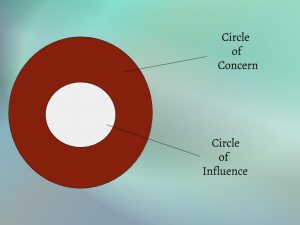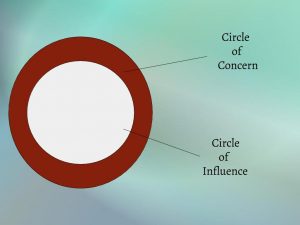Do you ever feel weighed down by worries? Overwhelmed with the things you need to do? Discouraged by problems you feel incapable of fixing?
We all have those days. The worst part is that that kind overwhelm feeds itself.
In the face of mountains of unmet need, it can be easy to easy to give up trying altogether. When making it through the to-do list seems impossible, it’s natural to want to ditch the list and watch Netflix instead.
Distraction is great while it lasts. But 5 seasons later, the list of worries that overwhelmed you to begin with has only gotten longer.
There is a better way that I teach my students to deal with feeling inundated by problems. It doesn’t rely on distraction, and it helps you to feel productive and accomplished again, despite having the same, long list of worries.
#1 Secret You Need to Know About Motivation
Worry immobilizes.
The more time you spend ruminating in your head about something, the harder is to take positive action, not only toward solving that problem, but toward solving any problem.
Think about it: imagine a time when you were really worried—so overwhelmed with worry that you felt like Atlas holding the world on your shoulders.
Choose a time when you were facing multiple problems at once—a time when personal, financial, job, or relationships issues all came up in the same period. Then throw in some worry about larger scale political, humanitarian, or environmental issues as well. Because those are usually the days when everything seems overwhelming, right?
Can you remember a day like that?
Now, how productive were you on that day?
For most people, the answer is not very. A little bit of stress can be a motivator. A deluge of worries causes you to lose traction and makes it hard to go anywhere.
Now imagine the opposite: a day when you felt productive and made meaningful progress toward your goals.
How much internal ruminating were you doing that day?
The answer? Probably not much. But I didn’t need to tell you that. You’ve experienced it.
What you may not be aware of is that you can actually use the relationship between those two factors: the amount you worry and the amount you accomplish, to help yourself feel more peaceful and be more productive.
How to Be More Peaceful and More Productive
Stephen Covey first described this relationship between peace and productivity. His model looks like this.

The circle of concern represents anything you are worried about, large or small: finances, relationships, job responsibilities, safety, local or national politics, etc. The circle of influence represents whatever you are actively doing something about.
The size of each circle represents the amount of your mental space dedicated to one or the other.
Covey’s genius observation was that the size of these two circles varies proportionally. When your circle of concern gets bigger—like it did on the overwhelmed-with-worry day you remembered earlier—your circle of influence gets correspondingly smaller. And when your circle of influence gets bigger—like it did on the meaningful and productive day you remembered earlier—your circle of concern correspondingly shrinks.


That means you can change how you feel (and how productive you are) just by choosing which circle to stand in.
You don’t have to wait until you have checked a certain number of items off your list, or until the majority—or any—of your problems have been solved. You just have change circles.
So how do you do that?
How to Feel Better by Moving into Your Circle of Influence
The best way to move into your circle of influence is to take action.
It doesn’t matter if the action you choose–or your execution of it–is perfect. It’s the process of doing that matters.
Once your brain realizes that you are in doing mode instead of worrying mode, it will free up space for more actions. Your worrying will decrease, and you will create the momentum you need to make meaningful progress.
Let me give you an example. I had a friend who found herself ruminating about the devastation to a major city when a hurricane passed through. She had lived there at one time and felt a special connection to the people. She wanted to help, but as a full-time mother of a toddler, it was not feasible for her to travel out of state to get involved with rebuilding.
The more she thought about the situation, the darker her mood became. She found herself feeling trapped and resentful towards her daughter. Everything else in her life started to seem more overwhelming than it had before.
The worry spread. She worried about not having enough money. She worried about a natural disaster impacting her new home. She worried about people she cared about being hurt or killed. The small concerns in her daily life even felt more pressing than usual.
She overcame this spiral by stepping into her circle of influence. She decided to make cookies with her daughter and sell them as a fundraiser for those impacted by the disaster.
Because of her efforts they were able to make a donation to the relief efforts. But that’s not the part I’m focused on right now.
The amazing thing for someone overwhelmed by worry was that taking action in that one area—fundraising—also changed how she felt about all the other areas in her life. Her worries about relationships and natural disasters also eased, even though she hadn’t done anything directly about those issues.
That’s the magic of the circle of influence.
When you focus on what you can do—no matter how small—all the other big things on your plate start to feel more manageable.
You don’t have to be perfect. You don’t have to change the world—or even solve all your own problems. You just have to take action.
How to Feel Better by Changing Your Language
A great way to gauge whether you are in your circle of concern or your circle of influence is to listen to your language—both the words spoken out loud and the words you tell yourself in your mind.
When you are in your circle of concern, your words are reactive. They will make you feel victimized, overwhelmed, and helpless. You will find yourself focusing on things you don’t have.
This isn’t fair. If only I had had different opportunities things would have worked out.
Did you hear how she spoke to me? If only I had more respect. . .
Why did this have to happen to me? I could be happy if I had different circumstances.
You aren’t peaceful or productive in this state of mind.
When you are in your circle of influence, your words are strong, and speaking them makes you feel powerful. The focus is on problem solving in the present—specifically those things you can do something about. Your will find yourself focusing on who you want to be and do.
I can choose to work hard and create excellent results.
I can set the example of how we will treat each other in our home.
I can find a way to build something positive in this situation.
In this state of mind, you feel a sense of control, regardless of how crazy the world around you may be. You aren’t immobilized by worry. You are peaceful and productive.
How to Experience Freedom from Worries
You’ve felt exhausted by worries that sapped your motivation and responsibilities too overwhelming to handle.
The more you thought about them, the heavier they felt.
How do I do it? You asked yourself.
How do I do it when there is no way one person can do it all?
How do I do it when it’s not fair, and I feel helpless?
But you don’t have to feel helpless anymore.
You are ready to take action.
As you focus your thoughts and your actions on making a positive influence, you feel relief and excitement.
You see yourself making progress.
The burden lifts.
You are free.
































5 thoughts on “Weighed Down by Worry? Here’s an Easy Shift to Regain Your Energy and Enthusiam”
I can’t tell you how much this post has helped me. It’s definitely time for me to step into the circle of influence. I used to pretty much stay in that circle until I got older. For the past 2 years I have been in the concern ( horrible ) circle. I have terrible anxiety and depression but after reading this I really want to get off my anxious butt and start doing something to help myself! Thank you so very much for writing this 🤗
I’m so glad it helped you, Stacey. I love the visual representation too.
Yes, It helps me also. Thank you for showing me how to change negative thinking.
Good stuff…not the easiest to do but I believe taking the steps, or “leaning into it” is a first step.
I have a framed quote in my room: “Whatever you think you can do or believe you can do, begin it. Action has magic, grace and power in it.” Goethe